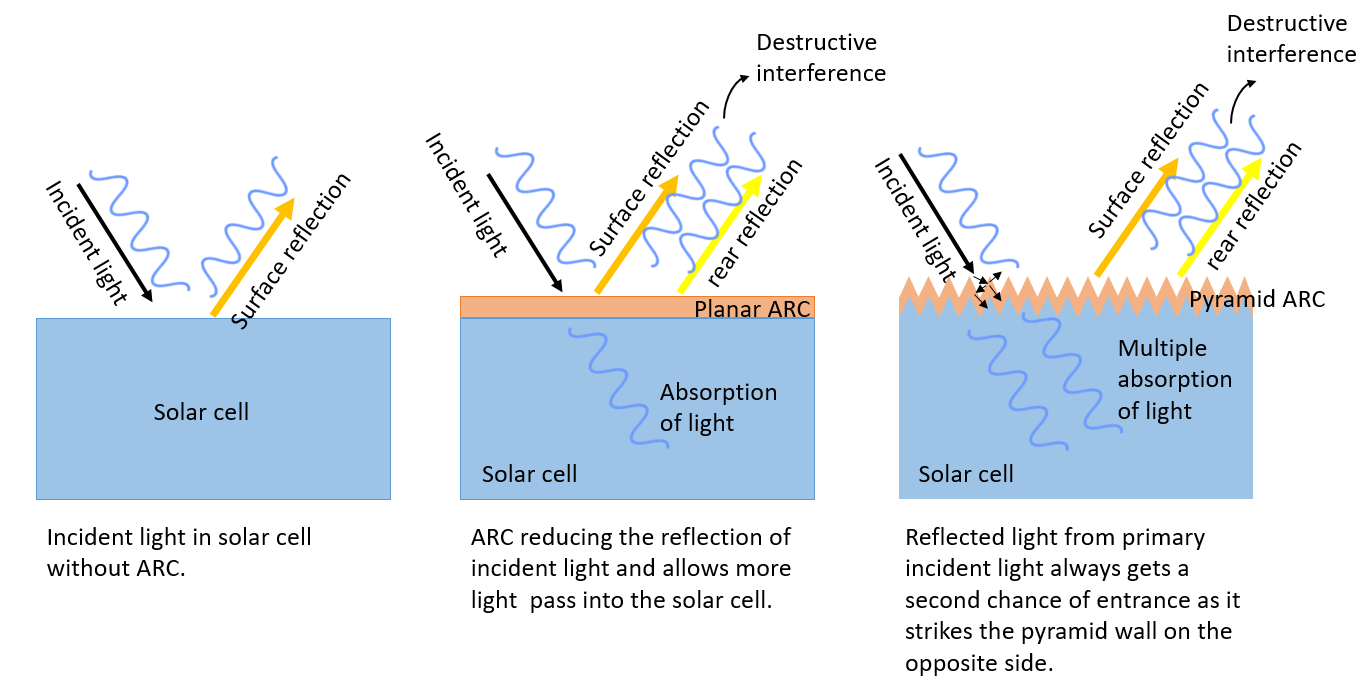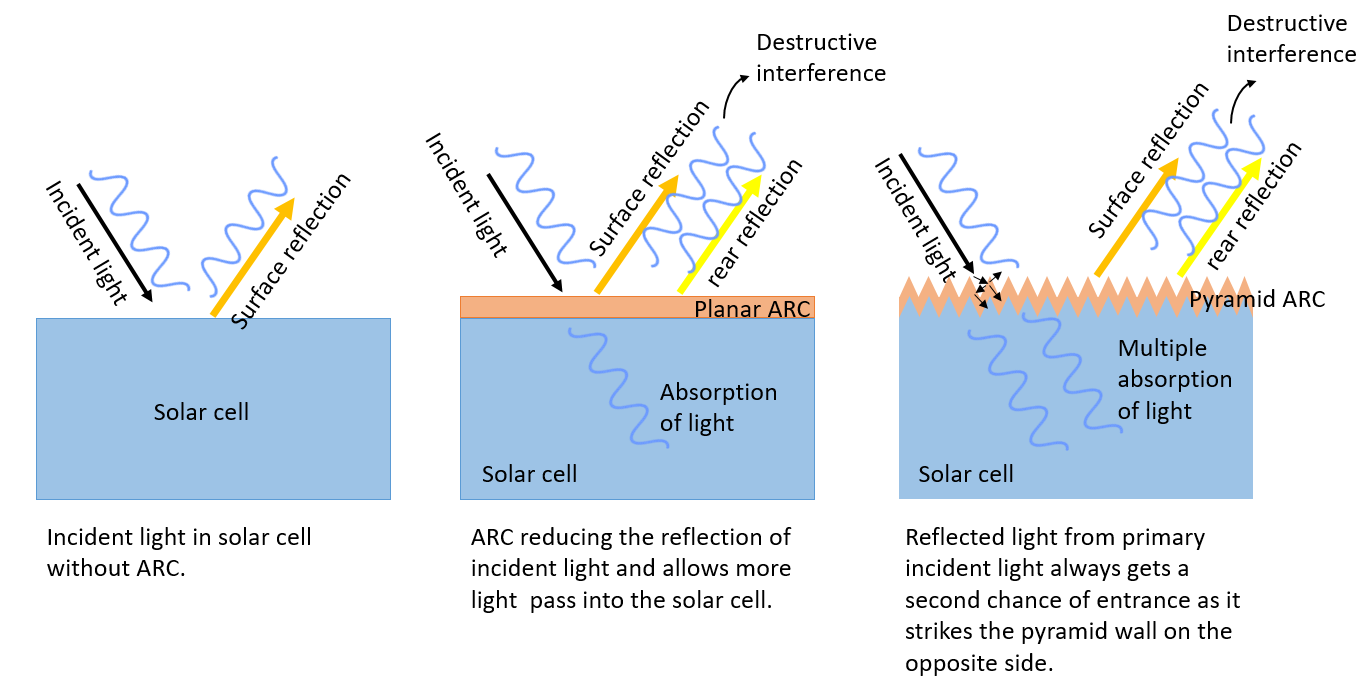Modelling and Optimization of A Light Trapping Scheme in A Silicon Solar Cell Using Silicon Nitride (SiNx) Anti-Reflective Coating
DOI:
https://doi.org/10.48048/tis.2023.5555Keywords:
Photovoltaics, Solar cell, Light trapping, Ray tracing, Absorption, SiliconAbstract
Solar cells system has been gaining remarkable attention in the photovoltaic (PV) industry in recent years. Therefore, many people used solar cells in their life. Hence, from time to time, many industries keep improve it to get the best of efficiency of the solar cell. In this work, it presents ray tracing of light trapping (LT) schemes in thin c-Si to enhance broadband light absorption within 300 - 1,200 nm wavelength region. For the ray tracing simulation, mono c-Si wafer with 100 μm thickness is investigated and solar spectrum (AM1.5G) at normal incidence is used. Random planar and upright pyramid front surface with silicon nitride (SiNx) anti-reflective coatings (ARC) with the difference thicknesses are the LT schemes being studies in this work. The broadband anti-reflective coating can effectively reduce the optical loss and improve the energy efficiency in the solar cells. The optical properties of the thin c-Si are analyzed with incremental LT schemes. Not only that, the current density also calculated from the absorption curve. Optical properties and current density were evaluated to find out the best thickness and refractive index of the silicon nitride (SiNx). The initial simulation results show that the solar cell current density is about 24.81 mA/cm2. A great Jmax enhancement in solar cell was achieved with utilizing the ARC thickness and type of front surface. Among the 6 proposed scheme, the scheme with upright pyramid front surface of 75 nm SiNx ARC thickness realized a good improvement in current density of 41.19 mA/cm2. This leads to Jmax enhancement of 66.02 % when compared to the reference c-Si.
HIGHLIGHTS
- Solar cell energy conversion efficiencies for commercially available multicrystalline silicon solar cells are around 14 - 20 % which still insufficient
- Energy conversion efficiency of solar cell can be enhanced by adding the anti-reflective coating on the front layer of light trapping scheme
- SiNx as a single layer anti-reflective coating with a certain thickness shown a good behavior in reducing the light reflection hence, effectively absorbing more light into the scheme and leads to enhancing the energy conversion efficiency
GRAPHICAL ABSTRACT
Downloads
Metrics
References
M Kamran and MR Fazal. Renewable energy conversion systems: Fundamental of renewable energy systems. Academic Press, London, 2021.
ASM Al-Obaidi and T NguyenHuynh. Renewable vs. conventional energy: Which wins the race to sustainable development? IOP Conf. Ser. Mater. Sci. Eng. 2018; 434, 012310.
P He, F Wen, G Ledwich and Y Xue. Small signal stability analysis of power systems with penetration of wind power. J. Mod. Power Syst. Clean Energ. 2013; 1, 237-44.
H Lala and S Karmakar. Continuous wavelet transform and artificial neural network based fault diagnosis in 52 bus hybrid distributed generation system. In: Proceedimgs of the IEEE Students Conference on Engineering and Systems (SCES), Allahabad, India. 2015.
M Hossain and N Fara. Integration of wind into running vehicles to meet its total energy demand. Energ. Ecol. Environ. 2017; 2, 35-48.
A Raheem, SA Abbasi, A Memon, SR Samo, YH Taufiq-Yap, MK Danquah and R Harun. Renewable energy deployment to combat energy crisis in Pakistan. Energ. Sustain. Soc. 2016; 6, 16.
A Ashfaq and A Ianakiev. Features of fully integrated renewable energy atlas for Pakistan; wind solar and cooling. Renew. Sustain. Energ. Rev. 2018; 97, 14-27.
NA Ludin, NI Mustafa, MM Hanafiah, MA Ibrahim, MAM Teridi, S Sepeai, A Zaharim and K Sopian. Prospects of life cycle assessment of renewable energy from solar photovoltaic technologies: A review. Renew. Sustain. Energ. Rev. 2018; 96, 11-28.
PA Owusu and S Asumadu-Sarkodie. A review of renewable energy sources, sustainability issues and climate change mitigation. Cogent Eng. 2016; 3, 1167990.
GV Fracastoro. The role of renewables in the energy crisis. E3S Web Conf. 2014; 2, 02003.
MV Dambhare, B Butey and SV Moharil. Solar photovoltaic technology: A review of different types of solar cells and its future trends. J. Phys. Conf. Ser. 2021; 1913, 012053.
A Qazi, F Hussain, NABD Rahim, G Hardaker, D Alghazzawi, K Shaban and K Haruna. Towards sustainable energy: A systematic review of renewable energy sources, technologies and public opinions. IEEE Access 2019; 7, 63837-51.
RI Jabbar. Modeling and analysis of different anti-reflection polymer coating on silicon solar cell using PC1D software. J. Mech. Eng. Res. Dev. 2020; 43, 222-32.
R Swanson. A vision for crystalline silicon photovoltaics. Progr. Photovoltaics Res. Appl. 2006; 14, 443-53.
M Gul, Y Kotak and T Muneer. Review on recent trend of solar photovoltaic technology. Energ. Explor. Exploit. 2016; 34, 4885-526.
A Blakers, N Zin, KR McIntosh and K Fong. High efficiency silicon solar cells. Energ. Procedia 2013, 33, 1-10.
NKA Hamed, MK Ahmad, NST Urus, F Mohamad, N Nafarizal, N Ahmad, CF Soon, AS Ameruddin, AB Faridah, M Shimomura and K Murakami. Performance comparison between silicon solar panel and dye-sensitized solar panel in Malaysia. AIP Conf. Proc. 2017; 1883, 020029.
LC Andreani, A Bozzola, P Kowalczewski, M Liscidini and L Redorici. Silicon solar cells: Toward the efficiency limits. Adv. Phys. 2019; 4, 15483053.
MZ Pakhuruddin. Ray tracing of light trapping schemes in thin crystalline silison for photovoltaics. Solid State Phenom. 2020; 301, 183-91.
B Dale and HG Rudenberg. High efficiency silicon solar cells. In: Proceedings of the 14th Annual Power Sources Conference, U.S. Army Signal Research and Development Lab, New Jersey. 1960.
P Campbell and MA Green. High performance light trapping textures for monocrystalline silicon solar cells. Sol. Energ. Mater. Sol. Cell. 2001; 65, 369-75.
SC Baker-Finch, KR McIntosh and ML Terry. Isotextured silicon solar cell analysis and modeling 1: Optics. IEEE J. Photovoltaics 2012; 2, 457-64.
O Hohn, N Tucher, A Richter, M Hermle and B Blasi. Light scattering at random pyramid textures: Effects beyond geometric optics. AIP Conf. Proc. 2018; 1999, 030002.
M Sun and PG Kik. Light trapping transparent electrodes with a wide-angle response. Optic. Express 2021; 29, 24989-99.
AS Blazev. Solar technologies for 21st century. River Publisher, Gistrup, Denmark, 2020.
R Saive. Light trapping in thin silicon solar cells: A review on fundamentals and technologies. Progr. Photovoltaics Res. Appl. 2021; 29, 1125-37.
H Heidarzadeh, M Dolatyari, G Rostami and A Rostami. Modeling of solar cell efficiency improvement using pyramid grating in single junction silicon solar cell. In: A Oral, ZB Oral and M Ozer (Eds.). 2nd ed. International congress on energy efficiency and energy related materials. Springer, Cham, Switzerland, 2015.
A El Amrani, I Menous, L Mahiou, R Tadjine, A Tousti and A Lefgoum. Silicon nitride film for solar cells. Renew. Energ. 2008; 33, 2289-93.
S Kermadi, N Agoudjil, S Samira, R Tala-Ighil and M Boumaour. Sol-gel systhesis of SiO2-TiO2 film as antireflection coating on silicon for photovoltaic application. Mater. Sci. Forum 2009; 609, 221-4.
K Ali, SA Khan and MZM Jafri. Effect of double layer (SiO2/TiO2) anti-reflective coating on silicon solar cells. Int. J. Electrochem. Sci. 2014; 9, 7865-74.
B Dieng, M Beye and AS Maiga. Optimization of silicon nitride antireflective nanostructures for silicon solar cells. In: Proceedings of the 7th International Energy and Sustainability Conference (IESC), Cologne, Germany. 2018.
S Duttagupta, F Ma, B Hoex, T Mueller and AG Aberle. Optimised antireflection coatings using silicon nitride on textured silicon surfaces based on measurements and multidimensional modelling. Energ. Procedia 2012; 15, 78-83.
Y Lee, D Gong, N Balaji, YJ Lee and J Yi. Stability of SiNx/SiNx double stack antireflection coating for single crystalline silicon solar cells. Nanoscale Res. Lett. 2012; 7, 50.
N Manavizadeh, A Khodayari and E Asl-Soleimani. An investigation of the properties of silicon nitride (SiNx) thin films prepared by RF sputtering for application in solar cell technology. In: DY Goswami and Y Zhao (Eds.). Proceedings of the ISES World Congress 2007 (Vol. I - Vol. V). Springer, Berlin, Germany, 2008, p. 1120-2.
MK Ray, S Sasmal and S Maity. Optimization of multijunction solar cell by wafer ray tracer for development of high photogenerated current. Int. J. Res. Eng. Tech. 2015; 4, 365-71.
KWA Chee, Z Tang, H Lü and F Huang. Anti-reflective structures for photovoltaics: Numerical and experimental design. Energ. Rep. 2018; 4, 266-73.
C Zhou, T Li, Y Song, S Zhou, W Wang, L Zhao, H Li, Y Tang, H Diao, Z Gao, Y Duan and Y Li. SiOx(C)/SiNx dual-layer anti-reflectance film coating for improved cell efficiency. Sol. Energ. 2011; 85, 3057-63.
TW Kuo, NF Wang, YZ Tsai, PK Hung and MP Houng. Broadband triple-layer SiOx/SiOxNy/SiNx antireflective coatings in textured crystalline silison solar cells. Mater. Sci. Semicond. Process. 2014; 25, 211-8.
MZ Pakhuruddin, J Huang, J Dore and S Varlamov. Enhance absorption in laser-crystallized silicon thin films on textured glass. IEEE J. Photovoltaics 2016; 6, 159-65.
NI Ibrahim and MMBE Omer. The effect of wavelength of light on solar electrical performance. In: Proceedings of the ASME 2020 Power Conference collocated with the 2020 International Conference on Nuclear Engineering, Anaheim, California. 2020.
PP Altermatt, Y Chen, Y Yang, A Ali and PJ Verlinden. Optical properties of industrially mass-produces crystalline silicon solar cells and prospects for improvements. In: Proceedings of the Optics for Solar Energy, Leipzig, Germany. 2016.
JK Selj, D Young and S Grover. Optimization of the antireflection coating of thin epitaxial xrystalline silison solar cells. Energ. Procedia 2015; 77, 248-52.
MA Green and MJ Keevers. Optical properties of intrinsic silicon at 300K. Progr. Photovoltaics Res. Appl. 1995; 3, 189-92.
J Mullerova, P Sutta and M Hola. Optical absorption in Si:H thin film: Revisitting the role of the refractive index and the absorption coefficient. Coatings 2021; 11, 1081.
H Zhitao, C Jinkui, M Fantao and J Rencheng. Design and simulation of blue/violet sensitive photodetectors in silicon-on-insulator. J. Semicond. 2009; 30, 104008.
H Wang, X Liu and ZM Zhang. Absorption coefficients of crystalline silicon at wavelengths from 500 nm to 1,000 nm. Int. J. Themphyics 2013; 34, 213-25.
S Lorch. Theory and measuring of antireflection coatings. University of Ulm, Baden-Württemberg, Germany, 2003, p. 15-20.
SB Khan, S Irfan, Z Zhuanghao and SL Lee. Influence of refractive index on antireflectance efficiency of thin films. Materials 2019; 12, 1483.
R Dewan, I Vasilev, V Jovanov and D Knipp. Optical enhancement and losses of pyramid textured thin-film silicon solar cells. J. Appl. Phys. 2011; 110, 013101.
T Lauinger, J Schmidt, AG Aberle and R Hezel. Record low surface recombination velocities on 1 V cm p-silicon using remote plasma silicon nitride passivation. Appl. Phys. Lett. 1996; 68, 1232.
R Hezel and K Jaeger. Low-temperature surface passivation of silicon for solar cells. J. Electrochem. Soc. 1989; 136, 518.
FL Riley. Silicon nitride and related materials. J. Am. Ceram. Soc. 2004; 83, 245-65.
P Hierrezuelo-Cardet, AF Palechor-Ocampo, J Caram, F Ventosinos, D Perez-del-Rey, HJ Bolink and JA Schmidt. External quantum efficientcy measurements used to study the stability of differently deposited perovskite solar cells. J. Appl. Phys. 2020; 127, 235501.
MM Hung, HV Han, CY Hong, KH Hong, TT Yang, P Yu, YR Wu, HY Yeh and HC Huang. Compound biomimetic structures for efficiency enhancement of Ga0.5In0.5P/GaAs/Ge triple junction solar cells. Optic. Express 2014; 22, A295-300.
MA Zahid, MQ Khokhar, Z Cui, H Park and J Yi. Improved optical and electrical properties for heterojunction solar cell using Al2O3/ITO double layer anti-reflective coating. Results Phys. 2021; 28, 104640.
T Markvart and L Castañer. Chapter IA-1 - principles of solar cell operation. In: A McEvoy, T Markvart and L Castañer (Eds.). Practical handbook of photovoltaics. 2nd ed. Academic Press, London, 2012.
P Hersch and K Zweibel. Basic photovoltaic principles and methods. Antimicrob. Agents Chemother. 1982; 58, 7250-7.
T Tiedje, E Yablonovitch, GD Cody and BG Brooks. Limiting efficiency of silicon solar cells. IEEE Trans. Electron. Dev. 1984; 56, 520-5.

Downloads
Published
How to Cite
Issue
Section
License
Copyright (c) 2022 Walailak University

This work is licensed under a Creative Commons Attribution-NonCommercial-NoDerivatives 4.0 International License.






